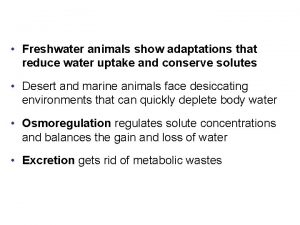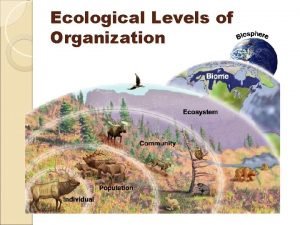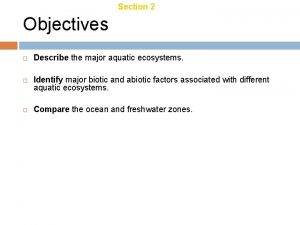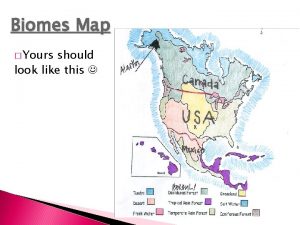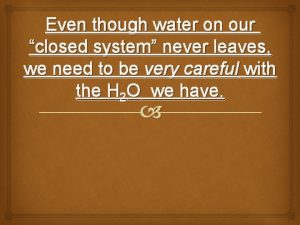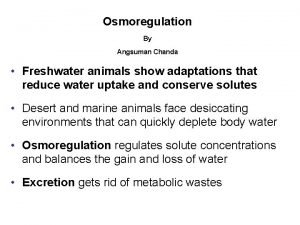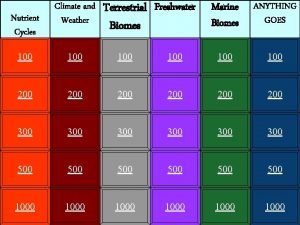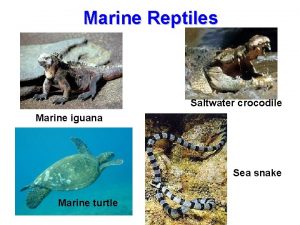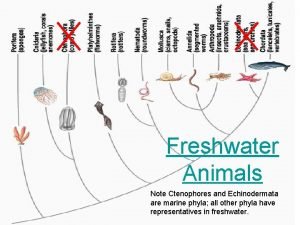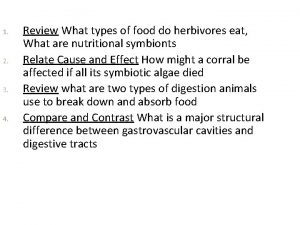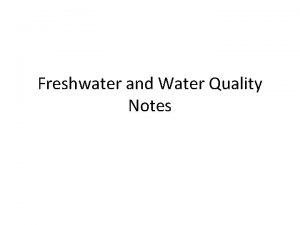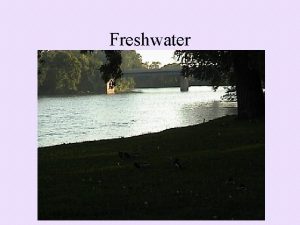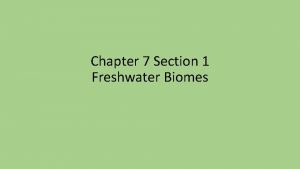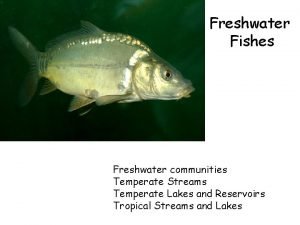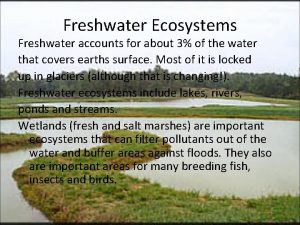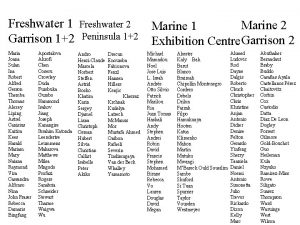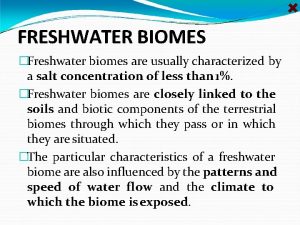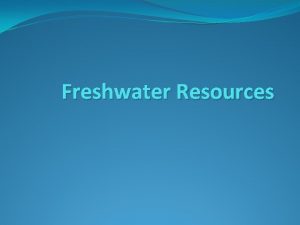Freshwater Where is all the Water Water source







































- Slides: 39

Freshwater

Where is all the Water? Water source Percentage of total water Oceans, Seas, & Bays 96. 5 Ice caps, Glaciers, & Permafrost 1. 80 Groundwater 1. 70 Lakes 0. 013 Soil Moisture 0. 001 Atmosphere 0. 001 Wetlands, Swamps 0. 0008 Rivers Biological Water 0. 0002 0. 0001

70% of fresh water on earth exists as ice South pole – 2 miles deep North pole – 15 feet deep Melting = 200 ft sea level increase + 45 ft - 375 ft If all the atmospheric moisture fell to the earth at once the sea level would rise only one inch

Available Freshwater Groundwater Lakes Soils Wetlands Rivers 0. 775% 0. 8%


Groundwater provides 98% of all available freshwater Total Water Withdrawals 21% United States Surface Water 62% Florida Groundwater More than 90% of Florida’s drinking water is from groundwater

Geographic Distribution

Location, Location 6 countries possess half of the world’s total renewable freshwater supplies. Brazil Colombia Russia Canada Indonesia China

Water Availability and Location South America: 3 of the 10 largest rivers 25% of fresh river water 5% of world population Greenland: 8 million gallons/person/day Alaska: 1 million gallons/person/day Congo: 130, 000 gallons/person/day Gaza: 37 gallons/person/day Gaza has the lowest per capita water availability in the world. Asia has 2/3 of world population, but 1/3 renewable water

Water Demand

The three major factors causing increasing water demand over the past century • population growth • industrial development • expansion of irrigated agriculture. Agriculture accounted for most freshwater withdrawal in developing economies in the past two decades

Population expected to grow to 9. 3 billion by 2050 2 billion people will be “water scarce” (UNFPA, 2002)

Industry and Income Country Agriculture High income Industry 30% 59% Middle income 74% 13% Low income 87% 8% Industrial use in China is expected to increase 5 -fold.

Agricultural Production 1% world energy Food production has grown with population 70% of all water used Irrigated land expected to expand by 23% in 25 years

Overall Consumption Irrigation for crops uses 65 - 70 percent of fresh supplies It takes over 528 gallons of water to produce enough food for one person for one day Over the past 30 years, the area of land under irrigation has increased by about 30%. Industry uses 20 -25 percent of available freshwater Steel and other raw materials for industrial products annual industrial water use in China could grow from 52 billion tons to 269 billion tons (5 X) within the next two decades Domestic use accounts for about ten percent of water use average consumption person is five gallons a day (WHO, UNICEF), but in the U. S. , Canada, and Western Europe the total consumption rises dramatically (>50 gal/day)

Supply and Demand Turning to Groundwater

Turning to Groundwater Use Local, On-demand Availability, Drought Resistance, Good Quality Heavy investment in groundwater exploration 50% of the world’s drinking water 40% of industrial water 20% of agricultural water 1. 2 billion urban citizens worldwide depend on groundwater

Turning to Groundwater Use India China Pakistan ½ the world’s total agricultural groundwater use In India, 80% of domestic supply and 70% of agricultural supply is from groundwater

Extra Credit: 1. _______% of fresh water on earth exists as ice 2. _____% of readily available freshwater is in groundwater 3. ___ has the lowest per capita water availability in the world 4. 70% of all water used is for ____________ 5. One of the 3 countries that account for 50% of world agricultural groundwater use.

Growing Pains

This part of China is mostly flat and the soil, replenished by silt carried down by the Yellow River, is well-suited to agriculture Shallow sand, gravel, rock North China Plain

½ China’s wheat, 1/3 corn Shallow aquifer largely depleted (renewable) 99, 900 wells were abandoned Shift to Deep fossil aquifer (non-renewable) Agricultural well depths can exceed 1000 feet ($) Municipal well depths can exceed 3000 feet Aquifer Levels dropping 3 ft/year China’s grain production has fallen from its historical peak of 392 million tons in 1998 to an estimated 358 million tons in 2005 (34 million tons-8%) China largely covered the drop-off in production by drawing down its once vast stocks until 2004, at which point it imported 7 million tons of grain.

India Population 1, 132, 446, 000 21 million wells water table is falling by 6 meters (20 feet) per year falling water tables have dried up 95 percent of the wells owned by small farmers drilling 3000 ft to reach water agriculture is rain-fed and drinking water is trucked in Pakistan Punjab Quetta Pakistan is growing by 3 million people per year In the Punjab plain, the drop in water tables appears to be similar to that in India. In the province of Baluchistan, water tables are falling by 11 feet per year. within 15 years Quetta will run out of water if the current consumption rate continues

Israel Cenomanian-Turonian Mountain Aquifer Besor highly permeable recharged from the West Bank Coastal Aquifer Width between 3 and 20 km depth to groundwater 60 m to 8 m chief resource of water for Gaza Besor Negev Gaza has the lowest per capital water availability in the world.

80 -100 sites lack infrastructure and mitigation measures

Saudi Arabia Disi Conveyance Project al-Disi aquifer Sandstone aquifer not subject to recharge Partly in Jordan 1984 Saudi national survey reported fossil water reserves at 462 billion tons Wheat on 2. 5 million acres of desert ½ has been depleted irrigated agriculture could continue for perhaps a few decades

The Sahara: Libya 1953 Nubian Sandstone Aquifer “fossil” water Formed 145. 5 to 65. 5 million years ago two million square kilometers world's largest fossil-water reserve equivalent to the flow of 200 years of water in the Nile River located near the center of the world's largest continuous stretch of desert

The Great Man-Made River Project the largest underground network of pipes in the world 1300 wells more than 500 m deep 10, 000 km³ 6, 500, 000 m³ water/day 4, 800 km³ Tripoli, Benghazi, Sirt 20, 000 km³ 4 major basins Water is 1/10 cost Of desalinization

United States

Wettest United States Rhode Island Florida Land (mi 2) 3, 618, 770 Water (mi 2) % water 79, 481 2. 2% 1, 545 500. 6 32. 4% 65, 975 11, 808 17. 9% North Carolina, Maine, Louisiana, Minnesota, Massachusetts Driest? New Mexico 121, 593 243 0. 2% Arizona 114, 000 364 0. 32% 24, 232 145 0. 6% West Virginia

Surface water 79% Texas California Idaho Illinois Groundwater 21% California Texas Nebraska Arkansas

Groundwater and Surface Water Use #1 irrigation #2 public Supply #1 power generation #2 irrigation Groundwater Surface water

Surface Water Groundwater

Agriculture and the Ogallala Aquifer Irrigation 1930 s 1970 s 600 wells 200, 000 wells ¾ of wheat traded on the world market Slowly replenished: Water tables have fallen By up to 100 ft 5 – 25”/yr Rainfall Pumping has declined by ½; new wells banned

irrigated Below is a link for a story on NPR http: //www. npr. org/templates/story. php? story. Id=12595774

Surface Water Groundwater

Summary Surface water 79% of withdrawals Ground water 21% of withdrawals #1 use of groundwater is for irrigation #1 use of surface water is for power generation Both ground and surface water withdrawals peaked in 1980 Texas uses the greatest amount of surface water California uses the greatest amount of groundwater

Florida 1700 rivers and streams (Feet to miles wide) One of the most productive Aquifer systems in the world 8 Bgal/d Water Withdrawn

 An ecosystem in which water either covers the soil
An ecosystem in which water either covers the soil Water and water and water water
Water and water and water water Name a line containing point a
Name a line containing point a Non living things in grasslands
Non living things in grasslands Climate of freshwater wetlands
Climate of freshwater wetlands Texas freshwater fish species
Texas freshwater fish species Saber toothed anchovy biome
Saber toothed anchovy biome Freshwater biome biotic factors
Freshwater biome biotic factors Biomes in water
Biomes in water Abiotic factors in freshwater biomes
Abiotic factors in freshwater biomes Fun facts about freshwater ecosystems
Fun facts about freshwater ecosystems Freshwater animals adaptations
Freshwater animals adaptations Freshwater basin
Freshwater basin Description of freshwater
Description of freshwater Biome foldable
Biome foldable Freshwater zones diagram
Freshwater zones diagram Freshwater ecosystem abiotic factors
Freshwater ecosystem abiotic factors Map of freshwater biome
Map of freshwater biome Freshwater fish marketing corporation
Freshwater fish marketing corporation Freshwater food web
Freshwater food web Pie chart of freshwater and saltwater
Pie chart of freshwater and saltwater Tertiary consumers in freshwater
Tertiary consumers in freshwater 14.2 uses of freshwater
14.2 uses of freshwater Saltwater fish in freshwater explode
Saltwater fish in freshwater explode Freshwater animals adaptations
Freshwater animals adaptations Freshwater biomes climate
Freshwater biomes climate Upstate freshwater institute
Upstate freshwater institute What is fwa in ship
What is fwa in ship Hsc alarm matrix
Hsc alarm matrix The land area that supplies water to a river system
The land area that supplies water to a river system Describe freshwater
Describe freshwater Zones of lake ecosystem
Zones of lake ecosystem Marine reptiles
Marine reptiles Texas freshwater fish identification
Texas freshwater fish identification Human impact on freshwater ecosystems
Human impact on freshwater ecosystems Order of animal
Order of animal Climate latitude
Climate latitude Freshwater ecosystems are classified as
Freshwater ecosystems are classified as Many freshwater invertebrates eliminate ammonia by
Many freshwater invertebrates eliminate ammonia by Hát kết hợp bộ gõ cơ thể
Hát kết hợp bộ gõ cơ thể











